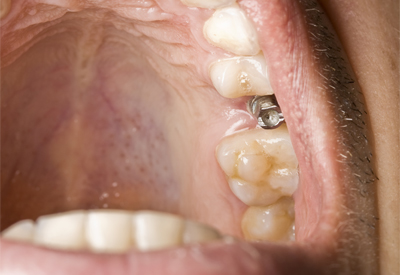Intro to Dental Implants Dental Implants 101 Dental Implants vs Dentures Single Missing Tooth
Multiple Missing Teeth Implant Supported Dentures Are Dental Implants right for me? FAQs
Many patients experience the loss of a single tooth due to injury, decay, or gum disease. Standard treatments for single tooth replacements include use of a removable partial denture, a fixed partial denture (bridge), or a dental implant. All of these options have their merits; however, implants are generally considered the most successful.
Removable Partial Dentures
Removable partial dentures are units in which replacement teeth sit on a base of gum-colored plastic, held together by a metal support structure. The partial is then attached to the gum line with a series of metal clasps. After placement, many patients express displeasure with the bulky denture and the metal aesthetic.
Fixed Partial Denture or Three Unit Bridge
A fixed partial denture, often called a bridge, suspends the replacement tooth or teeth between the remaining natural teeth on either side. The new tooth is cemented to the remaining teeth, referred to as abutments, which hold the prosthetic in place. Before the bridge can be applied, the abutment teeth must be ground down to allow the bridge to be fitted over top of them.
Prior to dental implants, a bridge was considered the most effective method of single-tooth replacement, yet it was not without disadvantages. The use of a bridge leads to jaw bone deterioration and tooth decay in the remaining abutment teeth. These complications have made fixed bridges a less desirable option in recent years as dental implants have become a more popular and widely used alternative.
Dental Implants for Single Missing Teeth

Today, dental implants are considered the best option for most single tooth replacements. They are the most natural treatment as they mirror the lost tooth and root. The titanium implant integrates into the existing bone and tissue in a process called osseointegration. The bond formed by this process is exceptionally strong and secure, allowing the implant to function like a natural tooth. The implant supports surrounding bone and tissue, enabling normal chewing and speaking and preserving the health of remaining teeth, gum, and bone. Implants offer a more permanent solution, although the crown of an implant may need to be replaced with extended use.
Caring for and maintaining your implant is like that of any other tooth; it requires daily brushing and flossing as well as dental check-ups twice a year. With basic hygiene, your implant can offer a lifetime of natural feeling teeth without impact your chewing or speaking.